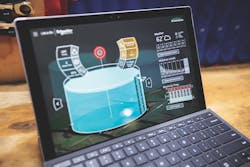Stewardship & Sustainability
About the author: Saadi Kermani is global business development manager for Schneider Electric Software. Kermani can be reached at [email protected] or 949.639.8707.
We currently are facing a shrinking supply of a vital natural resource—water. Globally, the agricultural sector consumes approximately 70% of the world’s water, and it is predicted that by 2050, water demand will rise by 55% in order to help support growing food requirements.
Local Water Challenges
Governments now are responding to increasing water demand by implementing new and rigorous regulatory requirements across the food chain. In New Zealand, farmers are limited to the amount of water they can contract from nearby rivers each day. They must obey strict compliance codes to retain their “consent to farm,” which means monitoring and reporting everything, including water application, uptake and runoff. Farmers operate in an extremely cost- and labor-intensive environment, and with the high administrative cost of compliance, threat of fees, or loss of consent, it is critical for farmers to remain competitive and keep operating costs to a minimum.
Recognizing this problem, New Zealand irrigation and water management company WaterForce sought a solution that would help farmers control and monitor farm irrigation and wastewater performance. The key design objectives were to automate the irrigation system, provide visibility of system status and performance, and reduce the burden of compliance. The solution also needed to be simple to set up, easy to use, and free from heavy information technology (IT) overhead costs or large capital expenditure, as most farms are not built to handle large software installations.
Intelligent Water Management
WaterForce and Schneider Electric developed SCADAfarm, an integrated, cloud-based automation and information management platform that leverages the Industrial Internet of Things (IIoT) to monitor and control geographically isolated assets. Powered by EcoStruxure Industry and built on Microsoft Azure, the water management portal helps simplify the integration between the connected products, edge control, apps and industrial analytics to provide a solution that responds to the specific needs of farmers.
Farmers can manage multiple farm operations, including controlling water flow on and off, setting pivot speed and direction, checking water pressure and soil moisture levels, and adjusting watering depth over a wide geographical area with multiple properties from a remote location. With the ability to handle millions of tags and unlimited users, the solution also is infinitely scalable. Additionally, there is no additional IT burden for farmers.
How It Works
SCADAfarm uses secure cellular connections and cloud technology for real-time control and monitoring functionality, overlaid with real-time weather data and GPS mapping to offer farmers insights on asset status, environmental factors and system performance. Since the system is continually monitored and recorded, farmers have an up-to-date account of water intake and use.
The system was designed to be a solution that preserves the water taken from local rivers and lakes, better enabling farmers to control the system vitals, including river level, pond capacity and pump speed. Knowing the current state of the watering pivots provides farmers with the peace of mind to leave the farm while still being able to view and control the irrigation system remotely, depending on the neighboring river flow and pond levels.
For example, if the daily application rate is 5 mm of irrigated water, farmers can demonstrate that the water is used by the plants and not running off into the environment (drainage or runoff). This proof is a key regulatory requirement for retaining consent to farm.
In addition to offering real-time insight, the SCADAfarm solution provides farmers with a complete historical picture of performance over time. It collects, stores and visualizes real-time data in the cloud. The system then transforms the data into charts, dashboards, newsfeeds and alerts that authorized users can access with any connected device. This has effectively become a live information feed for farmers to collaborate and provide better decision making.
Benefits Achieved
This solution has led to more efficient water and energy usage, among other benefits, including up to 50% reduction in energy costs, 30% reduction in water usage, better crop yields, easier compliance with regulatory requirements, and remote monitoring to save time otherwise spent traveling to inspect field assets. SCADAfarm also has been able to increase the visibility of irrigation system performance because farmers can access it from their connected devices.
Sustainable farming grows more important every day. Technology is a tool farmers can use to maintain sustainability within the environments where they operate. With a smart water irrigation application, farmers can be conscious of water scarcity and operate irrigation pivots with greater agility, efficiency, and sustainability. Remote SCADA systems are solutions that make farmers more productive and reduce water and energy usage and costs.
